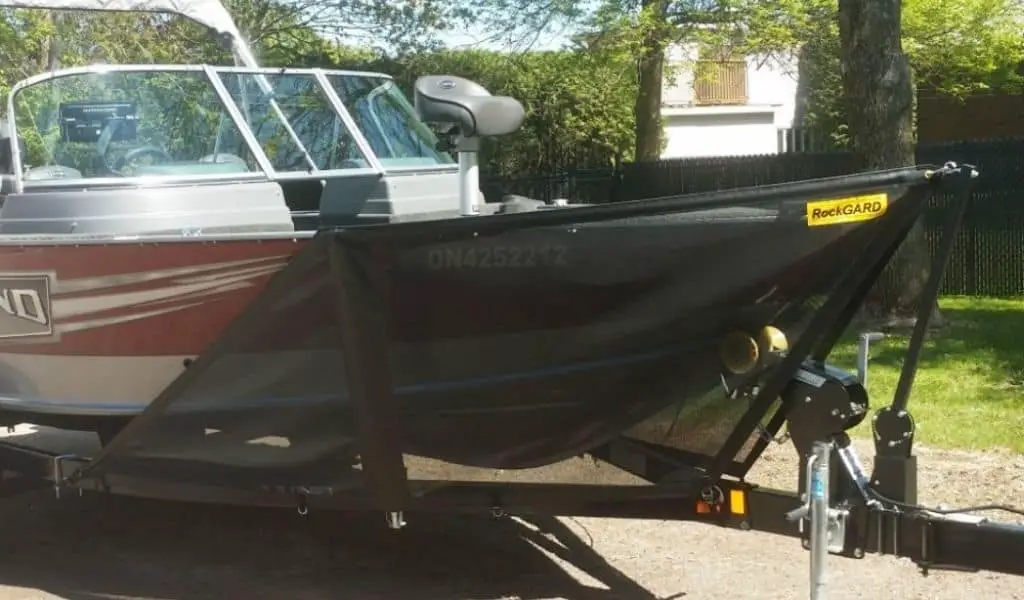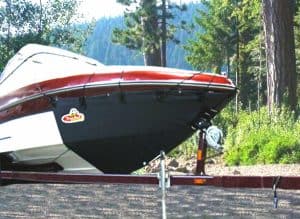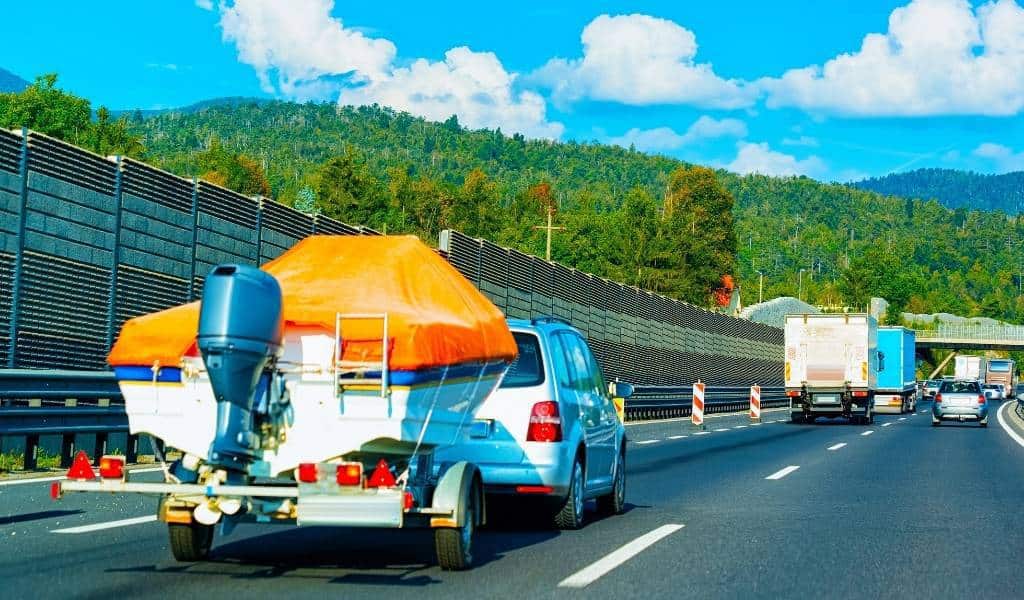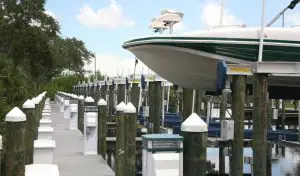Boating can be an incredibly exciting and fun thing for the entire family. Whether you are taking it slow and fishing or speeding across the lake so you can water ski or tube, there’s something for everyone to do. You even have the option of dropping anchor and letting the waves blissfully rock you to sleep as you soak in the sun.
Since a boat can be such a large investment, you want to make sure you are taking care of it properly. When transporting it from one destination to another, damage can occur—especially when rocks are thrown and hit the front of your boat.
You have several options when it comes to protecting your boat from rocks while towing, including using good driving practices and/or adding accessories or equipment to your vehicle or your boat. Using more than one method can further reduce damage that might occur from rocks when towing your boat.
5 Tricks to Avoid Damaging Your Boat While Towing It
To protect your boat while you are towing, follow the tips listed below:
1. Good Driving Practices
When towing your boat, it’s imperative that you have the right vehicle. You need to make sure the truck or SUV has enough engine power to get the equipment from one place to another. The size and weight of your boat will determine which size vehicle you need. If your vehicle can’t handle the added weight, this could lead to a blown engine or other damage.
In addition to having a vehicle that is capable of towing your boat, you also need to make sure it can handle different types of terrain. There are many places where boat ramps are made from gravel or other natural elements. In some cases, getting to these places requires getting off the paved road. Having a truck or SUV that can handle different terrains will ensure you and your family get to a place where you can have fun.
Not only does your vehicle need to be able to make it over the different types of terrain, but you need to ensure that your tires don’t throw rocks or other elements that can hit and damage the front of your boat. Some of the best ways to do this is to consider the road conditions, speed limit and driving distance:
- Consider Road Conditions
As you can imagine, driving on a gravel road with a lot of rocks will increase your chances of them hitting the front of your boat and causing damage. This shouldn’t deter you from traveling down these roads, as they are sometimes the only way to get to a really great boating spot. However, you need to be aware of how your drive. - Obey Speed Limits
Slowing down to prevent your tires from throwing rocks is a good idea. It can be tempting to fly down these roads, especially when you’re itching to get onto the water, but being patient will keep your boat in good condition and damage-free.
Slowing down will not only keep rocks from hitting the front of your boat, but it can also keep you from sliding off the road. If any of the tires on your vehicle or the boat trailer lose traction on loose gravel, this can pull you into a ditch, causing a lot more damage than a few rocks hitting your boat. - Minimize Driving Distance
In addition to the type of road you have to drive on to get to your destination, you also need to be aware of how long it will take you to get there. The longer the distance, the more chances you have of rocks hitting the front of your boat.
Again, this shouldn’t deter you from going to a place that you want to check out, but it will require some forethought and planning to reduce the chances of damage. If possible, check road conditions before heading out so that you know what to expect. While on the road, make sure to go the speed limit or even a bit slower to keep your boat safe.
2. Attach Mud Flaps
To protect your boat from rock damage, there are some equipment and accessories you can add to your vehicle and to the boat. These include mud flaps, trailer hitch shields, a RockGard, and a bow cover.
Mud flaps are generally made from heavy-duty materials and are placed near your rear tires, although you can also get some for the front as well. They act much like a shield. When the rocks hit the mud flap, they are deflected downward, back onto the road.
Mud flaps can be helpful in protecting your boat from rock damage, as well as keeping other debris from hitting it and getting it dirty. These are often an affordable and easy way to keep your boat protected from rocks.
You have a lot of options these days when it comes to mud flaps. They are available in two main types – they can be permanently installed behind your rear weals or as a removable system that are taken off your vehicle when they’re not needed. The removable type improve fuel efficiency by reducing wind drag when not installed.
I use the Rock Tamers to protect my boat. These mudflaps are large – which protects my boat, and removable – which helps with gas mileage and noise when I’m not towing my boat. They are available in a wide range of sizes, and their adjustable width makes them very adaptable to fit most vehicles.
One feature I really like is that the Rock Tamers can fit over the frame of a ball hitch. This is ideal for boat trailers because it keeps your hitch free. These flaps provide a great level of protection for your trailer and are easy to remove.
Rock Tamers is just one example of the great mudflaps that are available, however, there are plenty of cheaper ones if you like. For example, these Tow Tuff Universal Mud Flaps are easy to install and are effective at preventing vehicle damage.
3. Trailer Hitch Shields
Trailer hitch shields are another way to reduce the number of rocks that may hit your boat and cause damage.
They function in much the same way as mud flaps, but these are connected to your trailer hitch. They can vary in size depending on the type of hitch you have, but the goal is to create a surface for rocks to hit before hitting your boat.
4. RockGARD
If you decide to get a RockGARD, you have several different options to choose from. One of these includes a net-like accessory that attaches to the trailer to protect your boat from rocks. The RockGARD extends beyond the front of your boat to offer more protection.
The other option you have when it comes to a RockGARD is an extended mud flap that affixed to your back bumper. This creates a larger area to stop more rocks from getting through and hitting the front of your boat.

There is also a BellyGARD, which is custom built to fit your trailer. This affixes to your trailer frame to keep rocks from damaging your boat as you drive down the road.
Learn more about Rock GARD’s boat protection equipment in this video.
5. Bow Cover (Bow Bra)
If you don’t want to affix or attach any accessory to your vehicle or trailer, then you have the option of getting a bow cover, also know as a bow bra. These are usually clear plastic covers that stick directly onto the boat. In most cases, you won’t even know it’s there, but it will keep your boat protected from rocks.
These tend to be tailor made for your boat so it’s not something I’ve explored in great detail, however, check out Enduro products.

Repairing Rock Damage to Bow/Boat
If you find that you have some damage on your boat caused by rocks, it may be possible to fix them. First, you’ll need to determine what type of hull you have. Repairs will vary for boats made from fiberglass or aluminum.
When it comes to repairing fiberglass, if you have deep gouges or holes from rocks, you’ll need to use a resin or filler to fix them. It is advised you use an epoxy resin/filler because they adhere better than polyester products.
When repairing the gel coat on a fiberglass boat, you should be able to get a kit from the dealer where you bought your boat, in-store or online. If you get the kit from the dealer, they should be able to match the paint color. If not, there may be an option to add pigments to get it to match.
You’ll need to smooth the edges around the rock damage using a rotary grinder. You’ll also need to remove any old sealant, and then you can clean the area with acetone.
Place 2-inch wide masking or painter’s tape around the area that needs repaired. Leave yourself some space around the edge, about one-sixteenth of an inch. Once that is in place, once again clean the area with acetone.
After the area has been taped, you can then mix up the gelcoat. Make sure to add the right hardener for the type of gel you are working with. Mix thoroughly to ensure that it will cure properly. Using a putty knife, you will then apply the gelcoat over the area that needs repaired. You have about 10 to 15 minutes before the gel hardens.
Make sure to fill the hole slightly higher than the surrounding area. This will give you the surface you need to sand it down, as well as a little leeway to ensure that you have completely filled the hole. If you don’t plan on sanding, you can make the gel level with the surface of the hull.
When you have filled the damage, you will then spray it down with a PVA curing agent. If you left part of it raised, you can then wet-sand the cured gelcoat with 320-grit wet/dry sandpaper. Keep the sanding to the damaged area, as you don’t want to scratch the rest of your boat. Continue sanding until the area is level with the rest of the hull.
The Takeaway
Protecting your boat from damage while you’re hauling it back and forth is pretty simple. Drive slowly and safely. This will keep bouncing rocks and flying debris to a minimum. You can install devices on your vehicle such as mud flaps, boat shields, and other barriers and shields. If a rock manages to slip past your defenses, you can still restore your boat’s appearance by repairing the hull. Take some precautions to protect your boat while driving and think about buying some of the products mentioned above. They can go a long way to preventing damage and maintaining the value of your boat.






